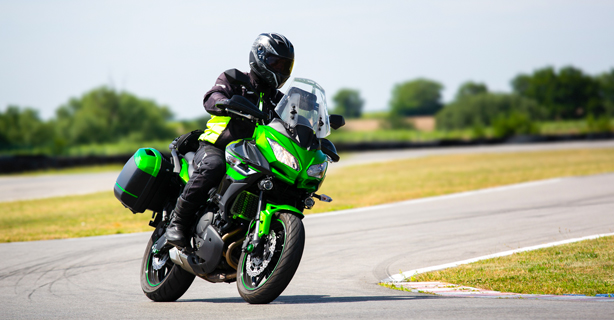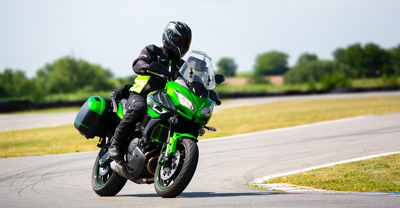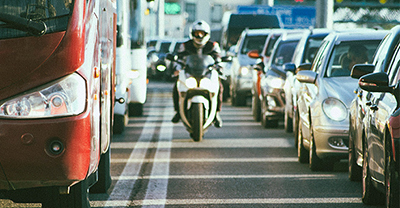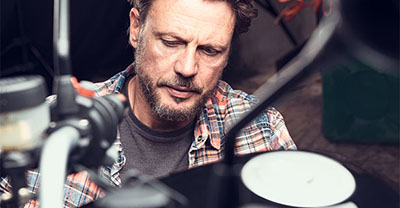Advanced riding techniques: Braking and cornering


You don’t need to be a sport biker to benefit from advanced riding techniques. More than likely, you won’t be cornering with your knee down on your next scenic byway cruise. But upleveling your braking and cornering skills can make you a more confident rider—able to quickly and safely identify hazards and react accordingly.
In the face of a 20% increase in motorcycle accident fatalities over the past decade*—due jointly to pervasive distracted driving and larger passenger vehicles on the road—protecting yourself while riding has become more important than ever.
Always wear a helmet
Gear up for safety before every ride
Pay attention to road conditions
Practice defensive driving
Increase your motorcycle skills
For hands-on guidance on advanced riding techniques, enroll in a quality motorcycle training course.
Motorcycle braking techniques
Proper braking techniques could be the difference between stopping safely and a potentially dangerous situation. It can also help prevent unnecessary wear and tear on your bike. Each time you brake, consider your location, braking time, braking distance, and weather conditions.
Basic motorcycle braking
When you need to stop your motorcycle, you can use the front brake on the handlebars, the rear brake near your foot rest, or a combination of the two. Stopping distance is an essential part of the braking equation, so whenever possible, give yourself plenty of room to slow down.
Front braking: Most of your braking performance comes from your front brakes. Use your index and middle fingers to squeeze gently on the front brake lever, gradually increasing pressure for smooth, controlled stops.
Rear braking: Use the rear brake of your motorcycle if you need to brake suddenly. While riding, keep your right foot hovering over the rear brake pedal. Even though you’re trying to stop abruptly, you'll want to apply gentle pressure to the brake.
Get to know the performance of your rear brake pedal on your bike. If it starts to lock up or you start skidding, ease off.
Combination braking: You can also combine your front and rear brakes for optimal stopping. To achieve braking balance, ensure your bike is upright and heading straight. Apply an even force on both brakes, adjusting as necessary based on the terrain and urgency of the stop.
Advanced motorcycle braking
For enhanced control of your speed and smoother transitions while frequently decelerating and accelerating, you can use an advanced braking technique called engine braking. Engine braking leverages your engine's resistance instead of relying on your brake pads. It is frequently used in tandem with your front and rear brakes.
This technique is particularly effective in wet conditions, and while accelerating downhill, where it can help you decelerate while remaining in control of your bike.
Engine braking: Let off the throttle and squeeze the clutch. Swiftly downshift, then smoothly disengage the clutch. You’ll hear the engine rev up and sound like it’s straining until it slows, but it’s not damaging your bike.
Rev matching: You can do this at the beginning of your engine brake to more smoothly transition when you downshift. Instead of letting off the throttle, give it a little “blip” before engaging the clutch to bring the RPMs closer to where they will end up after downshifting. This technique can reduce that straining noise.
Body dynamics: The position of your body can also enhance braking performance. For example, if you're stopping in a straight line as you decelerate, a slight lean forward can help slow you. This technique increases traction, improving stopping distance.
To prepare for emergency braking situations, find a safe, open location to practice. Never practice braking skills on a busy road. You want to build muscle memory and confidence. Start at low speeds and increase as you become comfortable.

Motorcycle cornering techniques
Cornering can be challenging, especially if you're new to riding. Make sure to learn the basics, get to know your motorcycle, and become familiar with the physics of riding. This preparation will help give you the confidence needed to approach any turn, at varied speeds, and adapt your technique based on road conditions.
Basic motorcycle cornering
Effective cornering requires proper body position as you direct the bike.
Lean forward slightly and bend your arms but keep them relaxed. Locking your arms can lead to instability. If possible, your elbows should be lowered so they’re in line with the handlebars.
Unlike four-wheeled vehicles, a motorcycle leans as it turns. As the tires lean, more traction is required to maintain the connection with the road. It’s what holds you in the curve and prevents your bike from sliding out.
Keep your vision high and your chin up, looking only where you want your bike to go—not at anything outside the turn. When you can see through the corner, start turning the bike.
Dip your shoulder into the corner and lean your upper body to the same side. There’s no need to lean heavily—keep your lower body aligned with your bike.
At slow speeds, you can corner your bike with direct steering—turning your handlebars in the direction you’re turning. But cornering while maintaining a higher speed requires counter steering—pushing the handlebar forward slightly on the side you’re turning to initiate the lean in that direction.
For example, when turning right at 25mph (like a big curve on a winding road), push the right handlebar forward slightly to help your bike lean to the right. Your bike will follow the lean of the counter steer and your body to complete a controlled turn.
Smooth throttle control ensures greater stability, contributing to these throttle-related techniques:
When you enter a corner, gradually roll on the throttle to achieve stability.
When exiting the corner, as your bike straightens, you can gradually increase the throttle for acceleration.
Advanced motorcycle cornering
Advanced cornering on a motorcycle takes the fundamentals of cornering—like counter steering and body positioning—and builds on them for smoother, faster, and more controlled maneuvers. Once you have the basics down, explore these techniques:
Trail braking: If you want more control of the speed of your bike through a turn, you can practice trail braking. Before you enter a corner, you squeeze the front brake to slow your motorcycle. In a normal corner, you would release right away, but here you gradually release the brake until you are leaning into the apex of the turn. This slows your turn and increases your reaction time.
Line selection: If you’re an experienced rider, you can assess an upcoming turn and choose the line you follow through it. Wait until you have a sight line through the corner to start your turn so when you hit the apex, you’re not in as deep a lean. Your arc (or line) is then tight enough that you exit the turn wide, but not so wide that you end up off the road.
Body steering: This technique manipulates the lean of the bike to make a turn similarly to counter steering. You can shift your body weight by positioning your body off-center, putting weight on the pegs, or pressing a knee against the tank. Body steering is considered more dangerous than counter steering and is more often implemented on the racetrack than the road.
Make sure you’re protected with motorcycle insurance
Advanced training can help you adapt and react in real time when the unexpected happens on the road. But when an accident happens, Dairyland® Insurance, a brand of the Sentry Insurance Group, can help protect you, your bike, and your finances. Contact us for a free quote!
The general information in this blog is for informational or entertainment purposes only. View our blog disclaimer.
*Data accuracy is subject to this article's publication date.









